
Female

Antenna
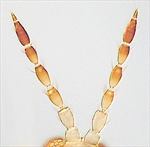
Antennae
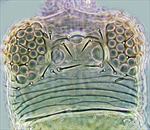
Head

Pronotum
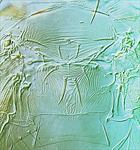
Meso & metanota
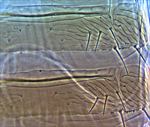
Abdominal tergites and pleurotergites

Tergite II margin
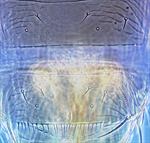
Tergites VII-VIII

Tergite VIII

Male sternites II-VII
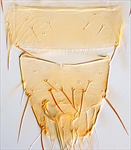
Male tergites VIII–IX

Fore wing
Both sexes fully winged. Body and legs yellow, major setae light brown; antennal segments IV–V brown distally, VI–VII brown; fore wings pale. Antennae 7-segmented; segments III & IV each with a short forked sense cone; VII short. Head wider than long; 2 pairs of ocellar setae; pair III small, arising just outside the ocellar triangle; postocular setae pair I slightly longer than ocellar setae III. Pronotum with 2 pairs of long posteroangular setae; posterior margin with 3 pairs of setae. Metanotum with irregular longitudinal lines converging to posterior margin, at anterior with curving transverse lines; median setae arising behind anterior margin; campaniform sensilla present. Fore wing first vein with 3 (sometimes 2) setae on distal half; second vein with row of about 15 setae. Abdominal tergite II with 4 lateral marginal setae; tergites V–VIII with paired ctenidia laterally, on VIII posteromesad to spiracles; tergite VIII posteromarginal comb complete, microtrichia long and slender; pleurotergites without discal setae. Sternite II with 2 pairs of marginal setae, III–VII with 3 pairs; sternites without discal setae.
Male smaller than female; tergite VIII with marginal comb complete medially; sternites III–VII with narrow transverse pore plate.
Thrips palmi is a widespread pest in tropical countries, and although present in Florida it has not yet been found in California. Populations in southern China and the mountains of southern Asia seem to represent a separate species, T. alatus Bhatti. Also remarkably similar in structure is T. flavus Schrank, a species that is widespread from Europe across Asia, but with ocellar setae III arising within the ocellar triangle just behind the first ocellus. The genus Thrips is the second largest genus in the Thysanoptera, and currently includes, worldwide, about 285 species. All members of genus Thrips lack ocellar setae I on the head, and they all have ctenidia on tergite VIII posteromesad to the spiracles. Other characters, such as number of antennal segments, number of setae on the fore wing veins, and number of discal setae on the sternites are variable between species (Palmer, 1992; Nakahara, 1994; Mound & Masumoto, 2005).
Highly polyphagous, and breeding in flowers and on leaves, particularly of Cucurbitaceae and Solanaceae. This thrips is a vector of the Tospoviruses, WSMV and GBNV, and causes serious damage to several food crops, including aubergines and potatoes.
Found throughout Asia, local in northern Australia, but widespread in tropical countries, including Caribbean and southern Florida. [not recorded in California]
THRIPIDAE - THRIPINAE
Thrips palmi Karny
Thrips palmi Karny, 1925: 10
Thrips clarus Moulton, 1928: 294
Thrips leucadophilus Priesner, 1936: 91
Thrips gossypicola Priesner, 1939: 41
Chloethrips aureus Ananthakrishnan & Jagadish, 1967: 381
Thrips gracilis Ananthakrishnan & Jagadish, 1968: 361.
Mound LA & Masumoto M (2005) The genus Thrips (Thysanoptera, Thripidae) in Australia, New Caledonia and New Zealand. Zootaxa 1020: 1–64.
Nakahara S (1994) The genus Thrips Linnaeus (Thysanoptera: Thripidae) of the New World. United States Department of Agriculture. Technical Bulletin 1822: 1–183.
Palmer JM (1992) Thrips (Thysanoptera) from Pakistan to the Pacific: a review. Bulletin of the British Museum (Natural History) Entomology Series 61 (1): 1–76.